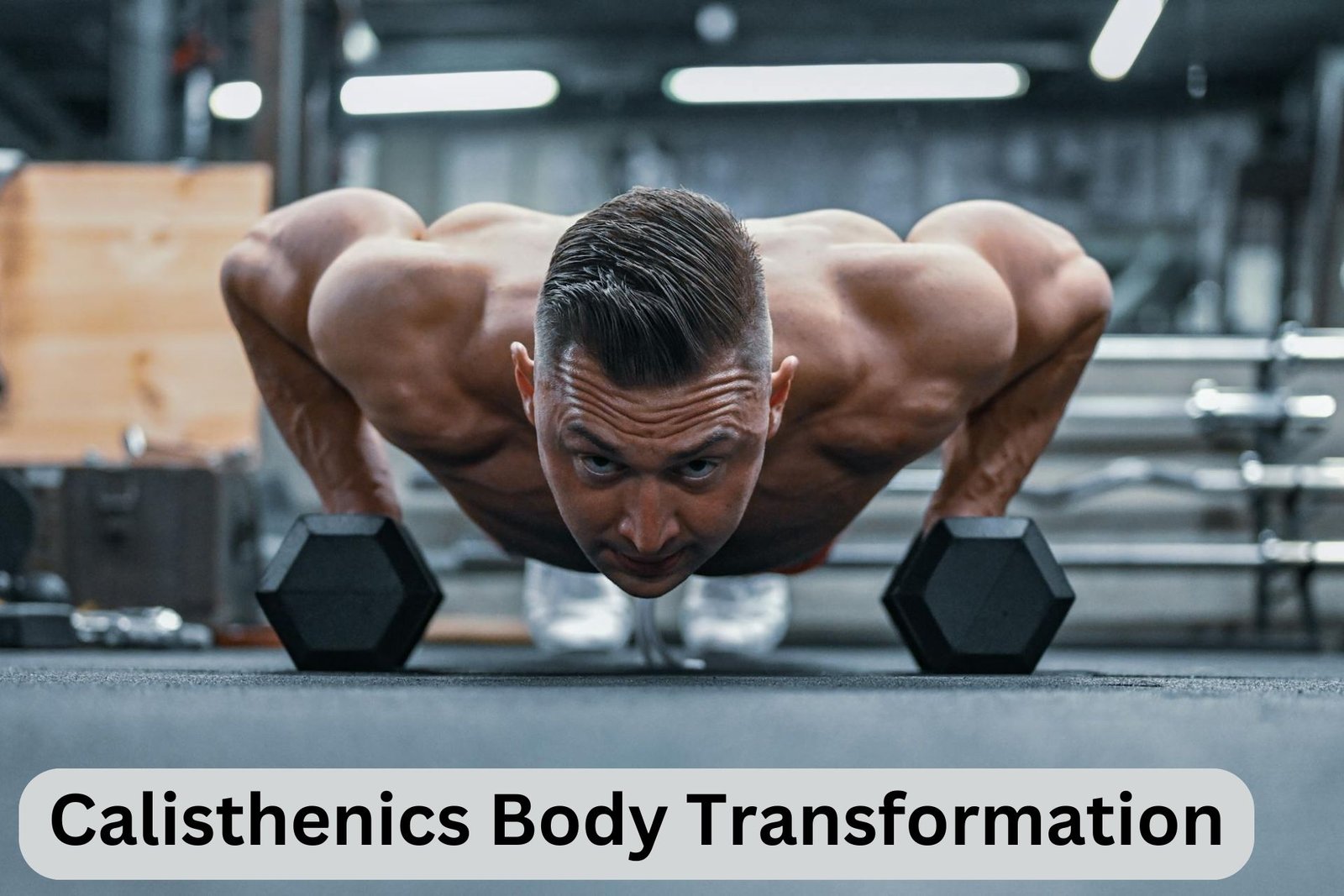Are you ready to transform your body using nothing but your own bodyweight?
Calisthenics can sculpt your physique, boost your strength, and skyrocket your fitness – all without stepping foot in a gym.
Let’s dive into the world of calisthenics body transformations and how you can achieve incredible results.
| Key Takeaways | Description |
|---|---|
| 💪 Bodyweight Mastery | Calisthenics uses only your body for resistance, offering a gym-free path to strength and fitness |
| 🏋️ Progressive Journey | Transform your physique over 12 months, from basic moves to advanced skills like human flags |
| 🥗 Nutrition Matters | Pair your workouts with a whole-food diet and proper protein intake for optimal results |
| 🚫 Common Pitfalls | Avoid overtraining, neglecting lower body, and ignoring proper form to maximize progress |
| 🔄 Lifestyle Shift | Embrace calisthenics as more than just exercise—it’s a transformative approach to fitness and life |
What is Calisthenics?
Calisthenics is a form of exercise that uses your body weight as resistance. Think push-ups, pull-ups, squats, and more. It’s like having a gym wherever you go!
Key benefits of calisthenics:
- Builds strength
- Improves flexibility
- Enhances body control
- Boosts endurance
- Requires minimal equipment
The Calisthenics Body Transformation Journey
Month 1-3: Laying the Foundation
The first few months are all about mastering the basics:
- Push-ups
- Pull-ups
- Squats
- Planks
- Lunges
Focus on proper form and gradually increase reps. You’ll start to notice improved strength and muscle definition.
Month 4-6: Progressing to Intermediate Moves
Now it’s time to level up:
- Diamond push-ups
- Pistol squats
- L-sits
- Muscle-ups (assisted if needed)
Your body will continue to change as you challenge yourself with harder moves.
Month 7-12: Advanced Skills and Fine-Tuning
In the later stages of your transformation:
- One-arm push-ups
- Front levers
- Handstand push-ups
- Human flags
These tough moves will push your limits and sculpt an impressive physique.
The Calisthenics Transformation Diet
You can’t out-train a bad diet. Here’s a simple approach:
- Eat whole foods: Fruits, veggies, lean proteins, whole grains
- Stay hydrated: Aim for 8-10 glasses of water daily
- Protein is key: 1.6-2.2 grams per kg of body weight
- Calorie balance: Slight surplus to build muscle, slight deficit to lose fat
Sample Calisthenics Transformation Workout
Here’s a brutal full-body routine to kickstart your journey:
| Exercise | Sets | Reps |
|---|---|---|
| Push-ups | 3 | 10-15 |
| Pull-ups | 3 | 5-10 |
| Squats | 3 | 15-20 |
| Dips | 3 | 8-12 |
| Lunges | 3 | 10 per leg |
| Plank | 3 | 30-60 seconds |
Perform this workout 3-4 times per week, resting 1-2 days between sessions.
Real Calisthenics Transformation Results
Don’t just take my word for it. Check out these mind-blowing transformations:
- John, 28: Gained 15 lbs of muscle in 6 months
- Sarah, 35: Lost 30 lbs and achieved her first muscle-up
- Mike, 42: Went from couch potato to human flag in 1 year
Tips for a Successful Calisthenics Transformation
- Be consistent: Show up even when you don’t feel like it
- Progress gradually: Don’t rush into advanced moves too soon
- Rest and recover: Give your body time to rebuild and grow
- Track your progress: Take photos and log your workouts
- Join a community: Find support and motivation from fellow enthusiasts
Common Calisthenics Transformation Mistakes
Avoid these pitfalls:
- Neglecting lower body training
- Overtraining and not allowing for recovery
- Ignoring proper nutrition
- Skipping warm-ups and cool-downs
- Not varying your routine
Explore the power of bodyweight training with these 17+ inspiring calisthenics body transformations. See real results and learn how calisthenics can build muscle effectively.
Understanding Body Composition and Calisthenics
To achieve the perfect calisthenics body, it’s crucial to understand your body composition. This refers to the ratio of body fat to lean muscle in your body. Calisthenics training can significantly transform your body shape, helping you reduce fat and build muscle mass naturally.
Key components of body composition:
- Body Fat Percentage: Lowering your body fat enhances muscle definition and reveals an awesome physique.
- Muscle Mass: Increasing muscle mass improves strength and contributes to a stunning physique.
- Flexibility and Balance: Calisthenics improves flexibility, resulting in a more flexible body and better body coordination skills.
By focusing on bodyweight exercises, you utilize your own bodyweight to create resistance, promoting a balanced and attainable body shape without the need for heavy weights.
Advanced Calisthenics Moves for Superhuman Strength
Ready to unlock superhuman strength? Advanced calisthenics moves challenge your body in new ways and require a higher level of skill and dedication.

Top advanced moves to master:
- Muscle-Ups: Combine pull-ups and dips into one fluid motion. This move builds incredible upper body strength and is a staple among calisthenics masters.
- Handstand Push-Ups: Develop shoulder and arm strength while improving balance and body control.
- Front Levers: Engage your entire core and back muscles to hold your body parallel to the ground.
- Human Flags: A true test of strength and body coordination skills, suspending your body horizontally while gripping a vertical pole.
Achieving these moves requires consistent practice and progression through various levels of difficulty. Embrace the challenge and watch your crazy calisthenics skills soar.
The Benefits of Weighted Calisthenics
Once you’ve honed your skills with pure bodyweight training, incorporating weighted calisthenics can accelerate your progress. Adding extra resistance pushes your muscles to adapt, leading to greater strength and muscle gains.
Why try weighted calisthenics?
- Enhanced Muscle Growth: Increase muscle mass for a more muscular physique.
- Strength Gains: Overload your muscles to build body strength beyond bodyweight limitations.
- Breaking Plateaus: Introduce new challenges to keep progressing.
- Versatility: Use weights like vests, belts, or even household items.
Popular weighted exercises:
- Weighted pull-ups and chin-ups
- Weighted dips
- Weighted push-ups
- Weighted squats and lunges
Remember to start with manageable weights and focus on maintaining proper form to prevent injury.
Creating a Calisthenics Circuit Routine
Circuit training involves performing a series of exercises with minimal rest in between. Calisthenics circuits are effective for building endurance, burning fat, and engaging the whole body.
Sample Calisthenics Circuit Routine
| Exercise | Reps | Rest Between Exercises |
|---|---|---|
| Jumping Jacks | 30 seconds | None |
| Push-Ups | 12 reps | None |
| Pistol Squats (each leg) | 5 reps | None |
| Pull-Ups | 8 reps | None |
| Mountain Climbers | 30 seconds | None |
| Dips | 10 reps | None |
| Plank | 60 seconds | 1 minute |
Repeat the circuit 3 times.
Tips for effective circuits:
- Full-Body Engagement: Choose exercises that target multiple muscle groups for a balanced workout.
- Variety of Movements: Incorporate different movements to prevent boredom and work different muscles.
- Progression: Increase reps, reduce rest times, or add weights as you improve.
- Consistency: Perform circuits 2-3 times a week alongside your regular training.
By incorporating different calisthenics circuits into your routine, you’ll experience calisthenics benefits like improved stamina and a killer-looking physique.
Discover one athlete’s journey in this 2-year calisthenics transformation AMA. Get insights into training, diet, and overcoming challenges.
Female Calisthenics: Transformations and Inspiration
Calisthenics isn’t just for men. Many women are embracing calisthenic exercises and achieving amazing body shape transformations. The focus on functional strength and flexibility makes it ideal for creating a realistic female body that’s both strong and agile.
Success stories:
- Emma’s Transformation Story: Started with basic moves and progressed to advanced skills like the muscle-up, showcasing a wonderful fitness journey.
- Sophia, the Calisthenics Enthusiast: Became a calisthenics trainer, inspiring others with her down-to-earth calisthenics approach.
- Lily’s Inspiring Calisthenics Body: Achieved a lean muscle physique and improved her body coordination skills through consistent bodyweight workouts.
Benefits for women:
- Functional Strength: Build strength that translates to everyday activities.
- Flexibility and Balance: Enhance your range of motion and stability.
- Body Confidence: Develop an awesome body and feel empowered.
Whether you’re aiming for specific calisthenic moves or just looking to improve your fitness, calisthenics offers a rewarding path for women.
Incorporating Complementary Exercises
To maximize your calisthenics transformation, consider adding complementary exercises to your routine. These exercises support your main workouts by targeting stabilizer muscles and preventing imbalances.
Examples of complementary exercises:
- Yoga: Enhances flexibility, balance, and mind-to-muscle connection.
- Pilates: Strengthens the core and improves posture.
- Cycling: Boosts leg endurance and cardiovascular health.
- Gymnastics: Develops advanced movement skills and body coordination.
By diversifying your training, you’ll achieve a more balanced physique development and prevent overuse injuries.
Embracing the Calisthenics Lifestyle
Transforming your body with calisthenics is more than just a workout—it’s a lifestyle change. Embrace the journey and keep pushing your limits.
Tips for lasting change:
- Set Clear Goals: Define what you want to achieve, whether it’s mastering a torso move like the front lever or reducing body fat.
- Stay Consistent: Make calisthenics a regular part of your routine.
- Mindset Matters: Cultivate a positive attitude and be patient with your progress.
- Seek Guidance: Work with a bodyweight trainer or join a community of calisthenics enthusiasts.
Remember, every step forward brings you closer to your dream calisthenics skills and an attainable body shape.
Witness an incredible 3-year calisthenics transformation from fat to fit. This video showcases the remarkable potential of consistent bodyweight training.
Conclusion
Calisthenics body transformation is a journey of self-discovery and physical mastery. It’s not just about building muscle or losing fat – it’s about becoming the best version of yourself.
Remember these key points:
- Progressive overload is crucial
- Perfect form is non-negotiable
- Nutrition fuels your transformation
- Balance different exercise types
- Rest and recovery are essential
- Patience and consistency are your best friends
Now, armed with this blueprint, it’s time to take action. Your calisthenics body transformation starts today. Are you ready to go from zero to hero?
Calisthenics Body Transformation FAQs
Results can vary, but most people start seeing noticeable changes within 4-8 weeks of consistent calisthenics training. Significant body transformation typically takes 3-6 months or more, depending on factors like diet, consistency, and initial fitness level.
Yes, you can build muscle with calisthenics alone. Progressive overload and proper nutrition are key. As you advance, you can increase difficulty by adjusting leverage, adding weight, or progressing to more challenging variations of exercises.
Neither is inherently better; both can lead to effective body transformations. Calisthenics offers benefits like improved body control, functional strength, and convenience, while weightlifting allows for easier progressive overload. The best choice depends on your goals and preferences.
A beginner routine might include push-ups, squats, lunges, planks, and assisted pull-ups or rows. Start with 2-3 sets of 8-12 repetitions for each exercise, 2-3 times per week. Gradually increase difficulty and volume as you progress.
For optimal results, aim to train 3-5 times per week, allowing for adequate rest between sessions. Beginners might start with 3 full-body workouts per week, while more advanced practitioners might use a split routine to train specific muscle groups more frequently.

